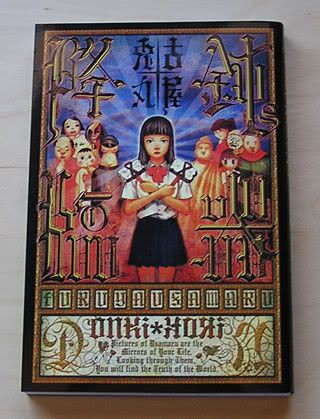
Donki Korin (鈍器降臨)
by Usamaru Furuya (古屋兎丸)
published in Da Vinci (Media Factory)
1 volume (1997-2004)
Amazon.jp
In an earlier post, I reviewed Usamaru Furuya's breakout masterpiece, Palepoli, and this review netted me a suggestion to check out its spiritual successor, Donki Korin (The Hammer Falls). Collecting six years' worth of the column he has run in the pages of serial novel and culture critique magazine Da Vinci since 1997, Donki Korin employs a unique structural format. On the right page of every spread is a short essay sent in by a reader and chosen by Furuya, and on the left page is a four-panel comic drawn by Furuya relating to the essay.
The book makes a good first impression with a gaudy, baroque cover that recalls Palepoli in both design and the variety of historical art styles employed. It also features hilariously bombastic blurbs in English on the front and back:
"Pictures of Usamaru are the Mirrors of Your Life."
"Looking through Them, You will find the Truth of the World."
"Readers wrote down Their Anger and Pleasure, then sent it to Usamaru."
"Usamaru received the Words of God, then drew a Hammer."
"Readers wrote the words of God, Usamaru drew a hammer of God."
"Usamaru and Readers shall bring down the Hammer together."
For the most part, the collaboration aspect is fruitful. The essays range from existential and poetic to absurd and comical, though typically more serious than not. Furuya's half of the collaboration is often simply a joke based on the subject or message of the essay. At the beginning he appears to be on a roll. In 1997 he was fresh off of Palepoli, which ran through 1996, and the art bears a strong similarity to the detail of that piece of work. His ideas, too, are fresh and smart, if not as surreal and boundary-destroying as what he exhibited in Palepoli. Perhaps he was attempting not to upstage the essay section (thus unbalancing the work), or perhaps he just wasn't interested in making the same kind of statements he had done previously.
However, over the course of the book (arranged chronologically) Furuya's half of the formula begins to suffer, his artwork growing simpler and more streamlined with time. There are a few throwbacks to his Palepoli days in the latter half of the book, both art-wise and with the use of recurring characters -- a feature he employed often in Donki's predecessor -- but for the most part there is a steady degradation of quality. In addition to the essay/manga content, there are a handful of short interviews sprinkled throughout, where Furuya called up some of the essay senders years later to discuss the subject and how things might have changed since then. While a nice touch, these interviews are mostly pointless and contain little added insight.
The best line of action to enjoying Donki Korin is to ignore my example and avoid comparing it to Palepoli. The book itself is an interesting concept, it is cleverly-executed and an entertaining read, regardless of its relation to the Usamaru Furuya's previous work.
2 comments:
I was looking through your manga list and noticed you had Wanitokagegisu by Minoru Furuya. I'm curious, is it as good as his previous works?
Teneis que ver esta pagina: Fanatic Manga. Es flipante, tiene material muy bueno, imagenes, videos, series, etc...
Post a Comment